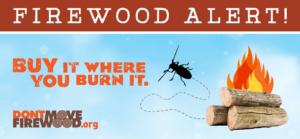Guest blog by Brandy Saffell, Program Coordinator for the Oregon Forest Pest Detector Program, Oregon State University Extension Service
The 2013 arrival of the emerald ash borer (EAB) in Boulder, Colorado, was a serious wakeup call to natural resource agency professionals in Oregon. Up until then, we had assumed that the Rocky Mountains would serve as a natural barrier to the westward spread of insects like EAB and the Asian longhorned beetle (ALB). The several hundred miles that EAB jumped from an infestation in the Midwestern or Eastern states to Boulder was likely due to the movement of infested firewood- which made us realize that EAB may only be one infested load of wood away from Oregon.
In response, the Oregon State University Extension Service created the Oregon Forest Pest Detector program (OFPD), which trains natural resource professionals and volunteers how to identify and report high priority invasive forest pests in the course of their daily work. Since our first workshop in 2015, over 350 participants from across the state have completed the OFPD training. When new pests or potential pathways arise, this network of trained detectors is not only a great resource for visual survey and early detection, but also education and outreach.

Oregon Forest Pest Detectors looking for signs of EAB during a workshop in Cathedral Park, Portland (Photo credit: Brandy Saffell)
One recent example of OFPD outreach was advance preparation for 2017 solar eclipse travelers. With the sudden influx of visitors from across the country in campgrounds and natural areas along the path of totality, there was reasonable concern that infested firewood could end up in Oregon. We used the Don’t Move Firewood solar eclipse campaign materials in our summer OFPD newsletter and encouraged detectors to spread the word to their clients, employees, and communities. We also marketed to other OSU Extension networks such as the Oregon Master Naturalists. We heard back from several detectors that they had used the materials in their own communications, such as an urban forester from Portland Parks & Recreation who directed the message to Portlanders via the Tree Bark newsletter. We also heard from some Master Naturalist volunteers who served as naturalist interpreters and firewood educators at the Baskett Slough National Wildlife Refuge during the eclipse.

Master Naturalist volunteers setting up an interpretation booth at Baskett Slough National Wildlife Refuge (Photo credit: Brett Lawrence)
In the next few years, the Oregon State University Extension Service would like to expand the OFPD program to reach out to more campground managers and volunteer hosts. We also hope to develop and implement a campground firewood exchange in cooperation with Oregon Parks and Recreation, where campers who bring firewood from outside Oregon can turn it in for local firewood.
Oregon Forest Pest Detectors is a partnership between the OSU Extension Service, Oregon Department of Forestry, USDA Animal and Plant Health Inspection Service (APHIS), USDA Forest Service, Oregon Department of Agriculture, and Oregon Invasive Species Council. The program would not be possible without funding received from USDA APHIS and the US Forest Service.
Thanks for reading this blog! You might also be interested in:






